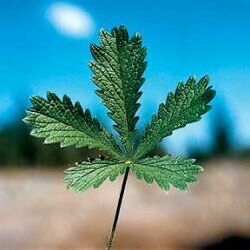
Priority: Contain
General: Long-lived plant in the Rose family that has many native look alikes. There are 27 potentilla’s found in BC.
Height: Grows between 30-70cm tall.
Flowers: Flowers are a pale yellow with 5 petals.
Leaves/Stems: One to several stems can grow from one root. Leaves have 5-7 leaflets in a hand-shape (palmate). The leaves are toothed.
Root: Fibrous and creeping horizontally.
Rough-fruited cinquefoil
There are 27 native potentilla’s that grow in BC.
Differences: The seeds from Sulphur cinquefoil is the only potentilla with wrinkles on their surface. You need a magnifying glass to look at the tiny seeds. Sulphur cinquefoil also has long, right angled hairs. LRISS recommends getting assistance with identification.
Where did it come from? Eurasia.
Where does it grow here? Sulphur cinquefoil is found on a wide range of soils & climates but occur mainly on grasslands and dry forests in BC. It often occupies roadsides, pastures, overgrazed rangelands and disturbed areas.
Reproduction: By seed and root. One plant can produce up to 1650 seeds. They are known to remain viable in the soil for up to 2 years.
When does it grow, flower & seed? Sprouts April-May. Flowers June-July. Seeds August-September.
Spreads By: Seeds can move around by birds, mammals, grazing animals by ingestion or attached to hooves/hair. Hay and livestock bedding material can also be contaminated by the seeds and move arount.
Plant Type: Long-lived perennial. One plant can live up to 20 years.
- It can take over areas and out-compete native plants.
- Unpalatable to grazing animals so it reduces the forage on the landscape for livestock & wildlife. It has a bitter tasting compounds.
- Review your property regularly for this species.
- Treatment Remove small patches before it flowers & sets seed. If removing by hand, make sure to dig out the root.
- Cover bare patches or disturbed soil by planting or seeding with non-invasives.
- Check areas where you have removed invasives for any new plants that year and in future growing seasons.
- Dispose of invasive plants responsibly. Bag them for disposal at the local landfill. Composting and burning are not recommended.
- Contact LRISS for specific treatment recommendations.
Southern Interior Weed Management Committee. 2016. Invasive Plants of the Southern Interior BC. 86pgs.
Okanagan Invasive Species Online website.
